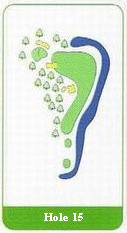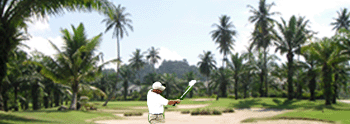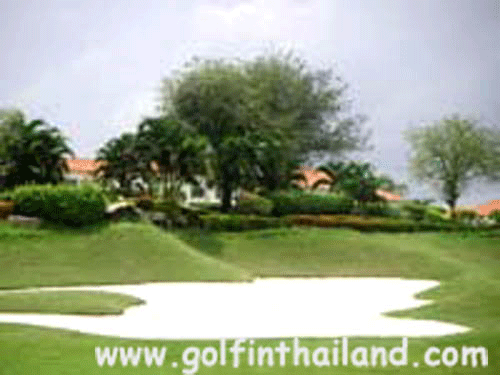 |
Hole 1 PAR 4 357 YDS.
This short par four, dog-leg right hole requires a long iron/fairway wood from the tee to leave a short iron into the green. The addition of four new fairway bunkers emphasize the need for an accurate tee shot. |
 |
Hole 2 PAR 3 197 YDS.
This hole plays slightly longer than the yardage suggest as the prevailing wind is into the players' face. With water right and behind of the green, and two large bunkers guarding the putting surface, this can be a challenging hole. |
 |
Hole 3 PAR 5 539 YDS.
This par five challenge requires a slight fade from off the tee to follow the left to right dog-leg shape and also to counter the sloping fairway. Long hitters can reach the relatively unprotected green in two shots. Good birdie opportunity here |
 |
Hole 4 PAR 4 416 YDS.
A new bunker on the right of the fairway has narrowed the landing area considerably. Hitting the fairway allows for a medium or short iron to the largest green on the course, so expect to see some long putts on this green. |
 |
Hole 5 PAR 3 203 YDS.
The longest par three on the course. Club selection is of a premium on this hole as there is water over the back of the green. The large bunker before the green awaits the mis-struck shots as does the out of bounds on the left running the length of the hole. |
 |
Hole 6 PAR 4 420 YDS.
A very long carry is required from the back tee onto the fairway on this deceptively difficult par four. Bunkers lie in wait to the right of the fairway, deep rough to the left. Into the prevailing wind this hole plays longer than at first appears. |
 |
Hole 7 PAR 4 357 YDS.
A short par four with a very narrow fairway. Most players will be hitting a long iron or fairway wood from the tee to leave a short iron into a deceptively deep green. The second shot requires good distance control to threaten the flag but there are many good pin positions on this green. Nevertheless a good birdie chance. |
 |
Hole 8 PAR 4 401 YDS.
The recent repositioning of this tee box brings the water on the left more into play. The new addition of a bunker on the left side of the fairway is designed to reduce the landing area, making for a tougher tee shot, Undulating green allows for difficult pin position each day. |
 |
Hole 9 PAR 5 564 YDS.
Only the brave, and long hitters, can reach this double dog-leg par five in two. The drive has to be struck well to carry the water and fairway bunker to leave a long second shot. Another long shot required over more water, to the green and into the wind. A great hole, where drama can be expected over the duration of the tournament. |
 |
Hole 10 PAR 4 350 YDS
Some will take their drive over the water on this short par four leaving a very short approach to the green. A little too long off the tee bring three large bunkers into play. The more accessible route requires a mid iron off the tee and a mid to short iron approach to the putting surface which is surrounded by large bunkers. |
 |
Hole 11 PAR 3 175 YDS.
This 175-yard hole plays into an island green. The turtle-backed green makes the tee short difficult to control with all sides of the putting surface sloping towards water. Expect some high numbers here this week, a true test of putting. |
 |
Hole 12 PAR 4 368 YDS.
The fairway on this short par four has been narrowed considerably to increase the difficulty of the tee shot. The fairway slopes from left to right towards a new bunker some 275 yards out to make the player think more about their drive |
 |
Hole 13 PAR 5 586 YDS.
The perfect tee shot needs to finish on the left side of the fairway. A big hit will leave a very long shot to the green requiring a left-to-right shot round the palm tree at the corner of the dog-leg. Approach shots are difficult to stop on the front-to-back sloping green. A par is a good score here. |
 |
Hole 14 PAR 3 168 YDS.
Predominantly the tee shot must carry over water. A deep bunker on the front left of the green collects stray tee shots resulting in a difficult downhill shot to most pin positions. Try not to go past the hole with your tee shot as you will be left with a very fast downhill putt. |
 |
Hole 15 PAR 4 369 YDS.
A dog-leg left challenge. An iron or fairway wood from the tee will leave a short iron to the green. Be careful not to hit it too far as the fairway slopes away from the tee and into deep rough. From the fairway this hole presents a great birdie chance as the green is the flattest on the course. |
 |
Hole 16 PAR 4 419 YDS.
This fairway is flanked by two large bunkers. Avoiding the traps is essential to shoot a good score on this hole. A large palm tree before the green needs to be avoided with the approach, so accuracy again is required to hit the wide but shallow green. |
 |
Hole 17 PAR 5 562 YDS.
This is our signature Par 5 hole. Even the longest drive won't have a go at this green. A well place secord shot will ensure an easier approach shot to a raise & shallow green. Anything left or short of the green is water is and right of the green is a large sand trap. |
 |
Hole 18 PAR 4 361 YDS.
Water all the way up on the left of this par four challenge makes this hole a difficult proposition. A new bunker on the right narrows the landing area which would force players to opt for a long iron or fairway wood from the tee box. The green is surrounded by bunkers, short right ang long, and water to the right. Watch out for a pin position back left which will be very challenging. |


![]()






















